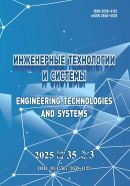UDK 004.896
DOI: 10.15507/0236-2910.028.201802.181-190
Interdisciplinary Modelling of Robots Using CAD/CAE Technology
Mikhail V. Chugunov
Head of Chair of Design and Technology Informatics, Ruzaevka Institute of Mechanical Engineering, National Research Mordovia State University (93 Lenina St., Ruzaevka 431440, Russia), Ph.D. (Engineering), Associated Professor, ResearherID: H-7452-2018, ORCID: http://orcid.org/0000-0001-5318-5684, This email address is being protected from spambots. You need JavaScript enabled to view it.
Irina N. Polunina
Associated Professor, Chair of Design and Technology Informatics, Ruzaevka Institute of Mechanical Engineering, National Research Mordovia State University (93 Lenina St., Ruzaevka 431440, Russia), Ph.D. (Pedagogy), ResearherID: H-7473-2018, ORCID: http://orcid.org/0000-0002-1093-8401, This email address is being protected from spambots. You need JavaScript enabled to view it.
Introduction. The paper describes an interdisciplinary approach that integrates physical and virtual (3D) modelling methods and tools in a high industrial undergraduate engineering school research environment and in an industrial design. The CAD/CAE procedures were connected directly with physical modelling for robotic systems of various types: mobile robots, manipulators etc. Thus, the design problems for the robot are solved in the both environments: physical and virtual.
Materials and Methods. The approach includes three separate parts: 1) SolidWorks; 2) Arduino, Fischertechnik and RoboRobo sets; 3) MS Visual Studio C++, COM technology SolidWorks and a POSIEX socket API (Application Program Interface). API and COM are used as the integration tools for physical and virtual parts. Corresponding Add-In or Stand-Alone applications extract the model features used for determining the necessary kinematic and dynamic parameters for robotics control. Robot webcams, sensors and feedback allow to establish a bidirectional connection between the behaviours of the 3D (virtual) and the physical models.
Results. The developed virtual (3D), physics models and software for the robots represent the integrated framework used in industrial design and research process. This interdisciplinary approach is realized as project-based learning in the educational and research process and in the industrial design practice.
Conclusions. The modern industry design is the interdisciplinary field with high level of integration between the disciplines. This research demonstrated that the developed integrated framework is effective for both industry design practice and engineering research.
Keywords: integrated interdisciplinary model, CAD/CAE-system, 3D modeling, virtual model, physical model, project-based learning, API programming, robotics systems, industrial design
For citation: Chugunov M. V., Polunina I. N. Interdisciplinary Modelling of Robots Using CAD/CAE Technology. Vestnik Mordovskogo universiteta = Mordovia University Bulletin. 2018; 28(2):181–190. DOI: https://doi.org/10.15507/0236-2910.028.201802.181-190
Authors’ contribution: M. V. Chugunov – development of technique and software for integrated mechatronics systems building; I. N. Polunina – computer processing, text and graphics editing.
All authors have read and approved the final version of the paper.
REFERENCES
1. ABaizid K., Cukovic S., Iqbal J., Yousnadj A., Chellali R., Meddahi A., et al. IRoSim: Industrial robotics simulation design planning and optimization platform based on CAD and knowledgeware technologies. Robotics and Computer-Integrated Manufacturing. 2016; 42:121–134.
2. Herbus K., Ociepka P. Determining of a robot workspace using the integration of a CAD system with a virtual control system. Paper Presented at the IOP Conference Series: Materials Science and Engineering. 2016; 145:5.
3. Zhu B., Song A., Xu X., Li S. Research on 3D virtual environment modeling technology for space tele-robot. Paper Presented at the Procedia Engineering. 2015; 99:1171–1178.
4. Kurazume R., Oshima S., Nagakura S., Jeong Y., Iwashita Y. Automatic large-scale three dimensional modeling using cooperative multiple robots. Computer Vision and Image Understanding. 2017; 157:25–42.
5. Popelka M., Struska J., Struska M. Using ultrasonic sensors to create 3D navigation model of area with ultrasonic sensors. International Journal of Circuits, Systems and Signal Processing. 2016; 10:82–87.
6. Gasteratos A., Beltran C., Metta G., Sandini G. PRONTO: A system for mobile robot navigation via CAD-model guidance. Microprocessors and Microsystems. 2002; 26(1):17–26.
7. Peng X., Lin S. B., Zhou J., Kelley J. Infusing computational engineering tools in engineering design sequence curricula. Computer-Aided Design and Applications. 2010; 7(2):183–194.
8. Ferrise F., Bordegoni M., Marseglia L., Fiorentino M., Uva A. E. Can interactive finite element analysis improve the learning of mechanical behavior of materials? A case study. Computer-Aided Design and Applications. 2015; 12(1):45–51.
9. Liu K., Peng X., McGary P., Yalvac B., Ozturk E., Johnson M. D., Valverde L. Integration of contextual exercises in computer-aided design education. Computer-Aided Design and Applications. 2015; 12:13–21.
10. Hasni A., Bousadra F., Belletete V., Benabdallah A., Nicole M., Dumais N. Trends in research on project-based science and technology teaching and learning at K–12 levels: A systematic review. Studies in Science Education. 2016; 52(2):199–231.
11. Cheng W., Wu X., Zhang Z., Liu F., Zhang M., Guo P. Effective project-oriented approach for training professional mechanical engineers in undergraduate education. International Journal of Mechanical Engineering Education. 2013; 41(4):289–296.
12. Zheng C., Hehenberger P., Le Duigou J., Bricogne M., Eynard B. Multidisciplinary design methodology for mechatronic systems based on interface model. Research in Engineering Design. 2017; 28(3):333–356.
13. Chugunov M. V., Kechemaykin V. N., Panin M. V., Polunina I. N., Makhrov G. A. Static strength and stiffness analysis for bearing structureelements of electro car BravoEgo. Naukovedeniye = Scientific Knowledge. 2016; 8(3):1–22.
14. Leitao P., Barbosa J. Building a robotic cyber-physical production component. 2016.
15. Tao Z., Wu T., He C. H. Research on mechanical manufacturing with creative design and combination of 3D mechanical manipulator based on Fischer technik. 2014.
16. Kaneps J., Gerina-Ancane A. Perfection of learning methods for mechatronics basic in mechanical engineering and industrial design studies. Engineering for Rural Development. 2016; 1:597–605.
17. Chugunov M. V., Schekin A. V. Practical aspects for development of Add-In SolidWorks applications on example of optimization problems. International Journal of Applied Sciences and Engineering Research. 2015; 4(4):494–499.
18. Bessas A., Benalia A., Boudjema F. Integral sliding mode control for trajectory tracking of wheeled mobile robot in presence of uncertainties. Journal of Control Science and Engineering, 2016.

This work is licensed under a Creative Commons Attribution 4.0 License.

















